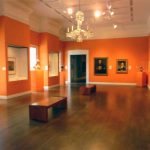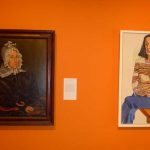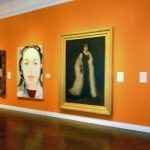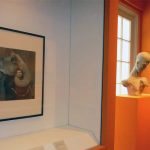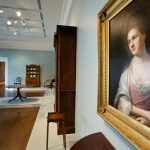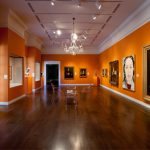Curator's notes: Extreme Makeover: Gallery 4 Edition

The newly installed Portraiture Gallery, 2011.
At long last, Gallery 4 has a new look! When I arrived at the Academy three years ago, I was stunned (and a little confused) by Gallery 4. Its soaring ceilings, French doors, hardwood floors, and picture-perfect views of the Mediterranean Courtyard made it prime museum real estate. So I had to wonder why it was given over to the display of crystal candleholders, silver teapots, and a Chippendale breakfront that, while impressive, stood cheerlessly and imposingly empty. It didn’t help that masterworks by James McNeill Whistler and Gilbert Stuart languished in an upper-floor gallery that few people knew about, much less visited, and that key examples of modernist sculpture were relegated to storage.

The “before” shot.
As I oriented myself to the collection, I realized that the Whistler and the Stuart were only the beginning of the Academy’s holdings in portraiture. Seriously, portraiture is truly one of our strengths: we have 18th-century British portraits, Colonial American portraits, Venetian portraits, Baroque portraits, society portraits, portrait busts, photographs, and works by 20th-century artists—like Alice Neel and Isamu Noguchi—who offered modernist interpretations of traditional portraiture modes. Looking at all this great artwork gave me an idea: To transform Gallery 4 into a dazzling space devoted to portraiture.
Organizing the space thematically meant stepping out of the comfort zone of art historical order, but I was up for the challenge. The first step was to develop a checklist (that’s museum-speak for a list of objects to be included in an exhibition or gallery), which meant locating, looking at, photographing, and studying all of the portraits in the museum’s storage areas and galleries, and culling from these the finest and most significant examples. With checklist in hand, it was time to plot out how to arrange the works in the Gallery 4 space. In a typical chronological museum display, this process can get tediously academic. This time, however, aesthetic relationships took center stage: works were placed alongside what best made them resonate, and the resonances—Alice Neel and folk art (!)—never failed to surprise us. Some decisions—like the one to place the hyper-modern and billboardesque Alex Katz right between classic studio portraits by Whistler and John Singer Sargent—were the product of brainstorming and happy coincidence. Others—like the juxtaposition of portraits by Stuart and John Singleton Copley—were calculated to illustrate a particular development. Still others—like the bright orange paint for the walls—were made after the layout was established, to tie the space together and make the artwork pop.
In the new Gallery 4, portraiture emerges not as microcosm of art history, but as a timeless and universal evocation of the richness of human interactions. I hope you will find it as thought provoking as I do. In the coming months, look for even more changes to the European galleries as we completely re-imagine our historical collections—part of the ongoing integration of the Honolulu Academy of Arts and The Contemporary Museum.
- The “before” shot.
- The newly installed Portraiture Gallery, 2011.

